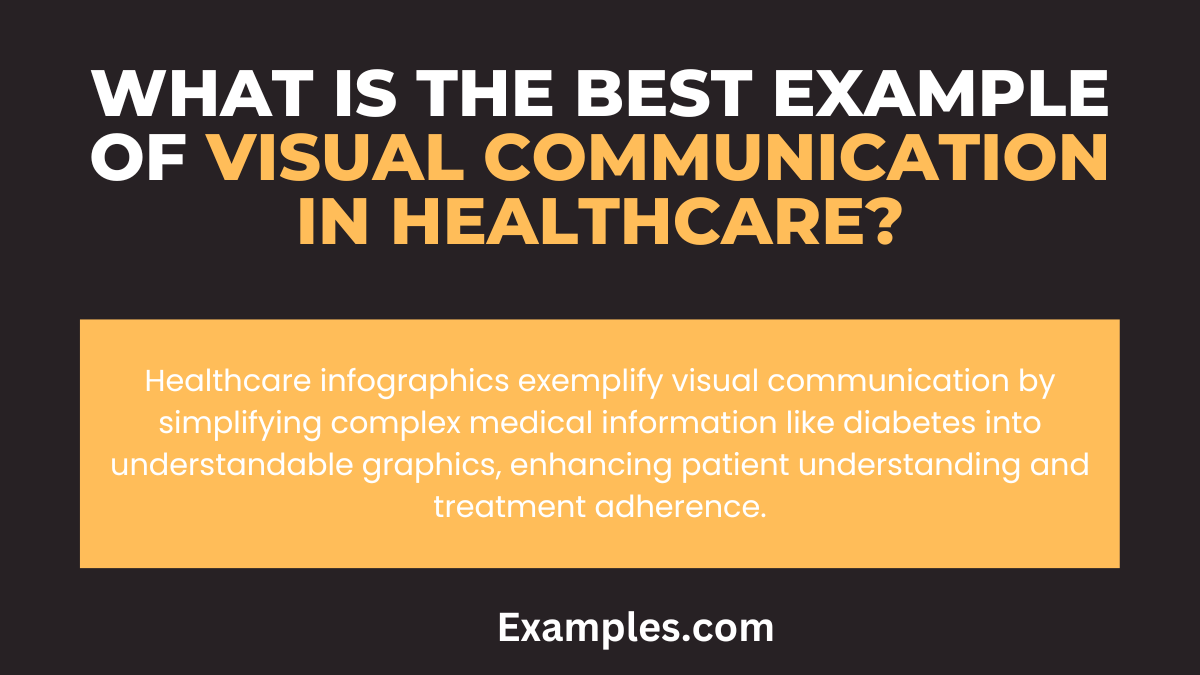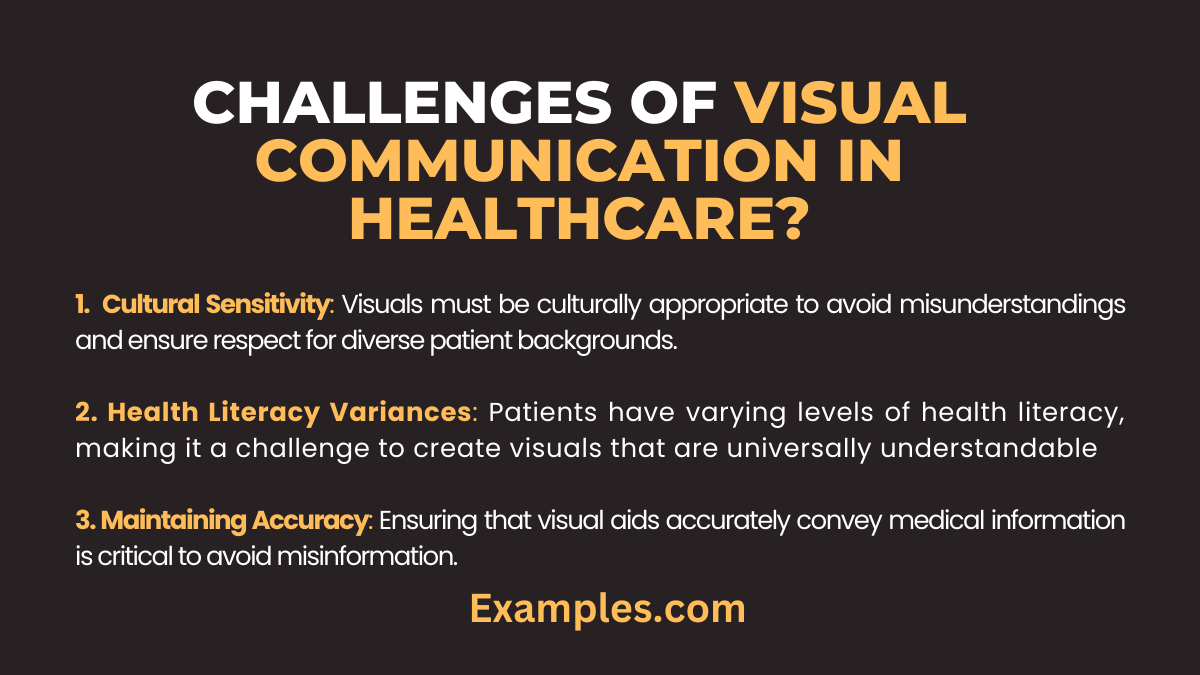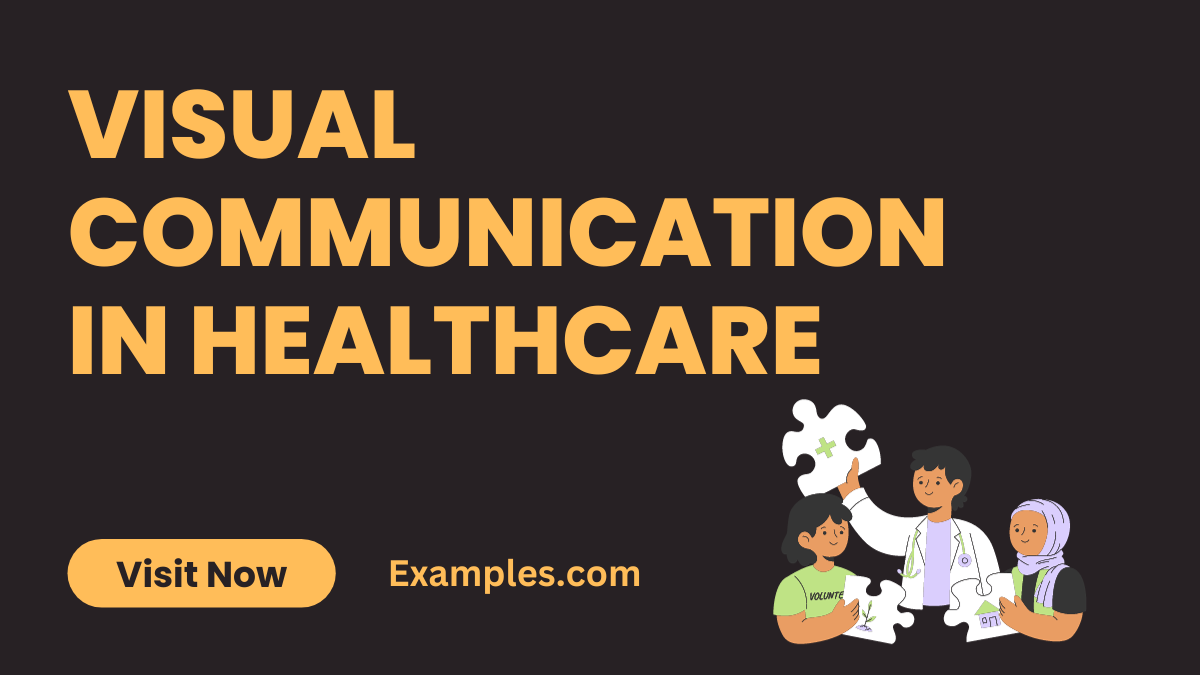19+ Visual Communication in Healthcare Examples
“Visual Communication in Healthcare – Complete Guide with Examples” offers an insightful journey into the world of healthcare communication. This guide showcases various Communication Examples that demonstrate how visual tools like infographics, diagrams, and charts can revolutionize patient understanding and care. From deciphering complex medical data to simplifying patient instructions, this resource is rich with practical examples and strategies, emphasizing the critical role of visual elements in enhancing communication within healthcare settings. Dive in to explore how visuals can transform patient experiences and outcomes.
Download Importance of Visual Communication in Healthcare PDF
What is Visual Communication in Healthcare?

Visual Communication in Healthcare refers to the practice of using visual methods, like diagrams, charts, and videos, to convey medical information. This form of communication translates complex health concepts and data into understandable, visual formats. It’s essential for enhancing patient understanding and engagement, ensuring they comprehend their health conditions and treatment plans. Effective visual communication in healthcare bridges the gap between medical expertise and patient knowledge, playing a crucial role in improving health outcomes and patient care.
What is the Best Example of Visual Communication in Healthcare?

A prime example of Visual Communication in Healthcare is the use of infographics for patient education. Infographics in healthcare distill complex medical information into easy-to-understand, engaging visual formats. For instance, an infographic explaining a specific medical condition like diabetes can illustrate symptoms, risk factors, and treatment options using simple graphics and minimal text. This method significantly improves patient understanding and adherence to treatment plans. It leverages Visual Communication Skills to make health information accessible and comprehensible, demonstrating the Importance of Visual Communication in healthcare settings. By using such Visual Communication Examples, healthcare providers can effectively communicate crucial information, which is an integral part of Visual Communication in the Media related to health education.
20 Visual Communication in Healthcare Examples

In the healthcare industry, visual communication examples is a key aspect of effective patient care and education. It involves using diverse visual tools and formats to clearly convey health-related information. This method, encompassing various Types of Visual Communication, significantly enhances patient understanding and compliance. From detailed Medical Diagrams and Flowcharts to informative Healthcare Infographic Design, each example serves a unique purpose in simplifying complex medical data. Such visual aids are essential for patient education, procedural explanations, and disease management, ensuring that healthcare information is accessible and comprehensible to all.
- Anatomical Charts: Detailed illustrations of the human body for patient education.
- Procedure Step-by-Step Guides: Visual guides for explaining medical procedures.
- Medication Schedules: Graphically represented medication timelines for patient adherence.
- Symptom Checklists: Visual lists to help patients identify symptoms.
- Disease Progression Graphs: Charts showing stages of diseases over time.
- Nutritional Guides: Infographics on diet and nutrition for patients.
- Exercise Instruction Cards: Visual aids for physiotherapy and rehabilitation exercises.
- Health Risk Infographics: Illustrations highlighting risks associated with health conditions.
- Interactive Health Apps: Digital tools for tracking and managing health.
- Vaccination Schedules: Clearly outlined vaccination timelines for patients.
- First Aid Visual Guides: Step-by-step visual instructions for emergency care.
- Hospital Wayfinding Signage: Visual signs for easy hospital navigation.
- Pre- and Post-Operative Care Infographics: Visual instructions for care before and after surgery.
- Medical Equipment Usage Guides: Illustrated guides on how to use medical devices.
- Health Awareness Posters: Posters for public health campaigns and awareness.
- Patient Journey Maps: Visual representations of a patient’s care pathway.
- Medical Test Explanation Charts: Charts explaining various medical tests and their purposes.
- Pediatric Growth Charts: Visual charts tracking children’s growth and development.
- Mental Health Awareness Visuals: Infographics and visuals promoting mental health.
- Telemedicine Interfaces: Visual interfaces for remote healthcare services.
Each of these examples represents a facet of visual communication in healthcare, showcasing how visual tools can enhance understanding, engagement, and effectiveness in patient care and health education.
Why is Visual Communication Important in Healthcare?
Visual communication plays an indispensable role in healthcare, bridging the gap between complex medical information and patient understanding. Its importance can be attributed to several key factors:
- Enhances Patient Understanding: Many patients find medical jargon and concepts challenging to grasp. Visual Tools in Patient Care, like diagrams and infographics, translate these complex ideas into more digestible visual formats, aiding in patient comprehension.
- Improves Patient Compliance: When patients clearly understand their health conditions and treatment plans through Healthcare Infographic Design and Medical Visual Aids, they are more likely to follow medical advice and adhere to treatment regimens.
- Facilitates Effective Communication: Visual Communication in Healthcare is essential for effective communication between healthcare providers and patients, especially in multicultural settings where language barriers exist. Visual aids can transcend language barriers and convey critical information universally.
- Supports Health Literacy: Visual Patient Information Guides and Medical Chart Visualizations play a crucial role in enhancing health literacy, empowering patients to make informed decisions about their health and treatments.
- Reduces Misinterpretation: Clear and concise visual communication reduces the chances of misinterpretation of medical instructions, which is vital for patient safety and effective treatment outcomes.
- Aids in Quick Decision Making: In emergency situations, Clinical Photography Techniques and visual cues can facilitate quick and accurate decision-making, which can be life-saving.
- Enhances Patient Engagement and Experience: Engaging visual content, such as Health Awareness Visual Campaigns, can make patients more engaged in their own health and wellness, leading to better healthcare experiences and outcomes.
- Efficient Training of Healthcare Professionals: Visual tools are not only beneficial for patients but also for training healthcare professionals. They aid in the quick and effective understanding of medical concepts and procedures.
- Supports Remote Healthcare: With the rise of telemedicine, visual communication becomes even more crucial. It ensures that patients and doctors can communicate effectively, even when not physically present in the same location.
What are the Challenges of Visual Communication in Healthcare?

While Visual Communication in Healthcare is invaluable, it comes with its unique set of challenges that can impact its effectiveness. Understanding these challenges is crucial for healthcare professionals to enhance their Visual Communication Skills and ensure the delivery of effective patient care.
- Cultural Sensitivity: Visuals must be culturally appropriate to avoid misunderstandings and ensure respect for diverse patient backgrounds.
- Health Literacy Variances: Patients have varying levels of health literacy, making it a challenge to create visuals that are universally understandable.
- Maintaining Accuracy: Ensuring that visual aids accurately convey medical information is critical to avoid misinformation.
- Complexity of Medical Information: Simplifying intricate medical concepts into visuals without losing essential details is a significant challenge.
- Language Barriers: Translating visual content into different languages can be complex, yet it’s essential for multilingual patient populations.
- Keeping Visuals Updated: Medical knowledge and guidelines are constantly evolving, requiring regular updates to visual materials.
- Accessibility for Disabilities: Creating visuals that are accessible to patients with disabilities, such as visual impairments, is essential.
- Balancing Aesthetics and Clarity: Striking the right balance between aesthetic appeal and clarity of information in visuals can be challenging.
- Patient Engagement: Designing visual communication tools that effectively engage and motivate patients is crucial for successful health outcomes.
- Technological Integration: Effectively integrating visual tools in digital health platforms while maintaining usability and functionality.
- Cost and Resource Constraints: Developing high-quality visual materials can be resource-intensive and may pose financial challenges for healthcare providers.
- Privacy and Confidentiality: Ensuring that visual communication respects patient privacy and confidentiality, especially in digital formats.
What are the Factors that Interfere with Visual Communication in Healthcare?
Effective Visual Communication in Healthcare is crucial for patient understanding and care. However, various factors can interfere with its efficacy:
- Cultural and Language Barriers: Different cultural backgrounds and languages can lead to misinterpretation of visual aids. Tailoring communication to accommodate these differences is vital.
- Health Literacy Levels: Patients have varying levels of health literacy, which can affect how well they understand medical visual aids. Complex visuals might confuse patients with lower health literacy.
- Age-Related Factors: Older patients may have vision impairments or cognitive challenges that make it difficult for them to understand certain types of visual communication.
- Technological Limitations: In some healthcare settings, especially in under-resourced areas, the lack of advanced technology can limit the use of digital visual tools.
- Design Complexity: Overly complex or cluttered designs can confuse rather than aid patient understanding. Simplicity and clarity are key in healthcare visuals.
- Emotional State of Patients: Patients’ emotional states, especially if they are anxious or distressed, can impact their ability to process and understand visual information.
- Accessibility Issues: Visual aids must be accessible to patients with disabilities, including those who are visually impaired, to ensure effective communication.
- Quality and Accuracy: Poor quality or inaccurate visual aids can lead to misunderstandings and potentially harmful outcomes in patient care.
- Over-reliance on Visuals: Solely depending on visual communication without verbal explanations can lead to gaps in understanding, especially in complex medical scenarios.
- Patient Engagement: The level of patient engagement can significantly impact the effectiveness of visual communication. Engaged patients are more likely to understand and follow visual instructions.
How Do You Show Communication in Healthcare?
Communication in healthcare is shown through clear, patient-friendly visuals like diagrams, infographics, and charts, aiding in patient understanding and effective treatment conveyance.
How is Visual Communication Used in Healthcare?
In healthcare, visual communication is used to simplify complex medical information through charts, infographics, illustrations, and videos, enhancing patient understanding and engagement.
What is the Main Purpose of Visual Communication?
The main purpose of visual communication, especially in healthcare, is to convey complex information in an easily digestible, clear, and engaging manner, improving patient understanding and healthcare outcomes.
In conclusion, the role of visual communication in healthcare is undeniably significant, bridging the gap between medical professionals and patients, and playing a key role in enhancing patient understanding, compliance, and overall care quality. The power of visual tools in effectively communicating complex health information is a testament to the evolving landscape of patient-centered care. To further explore the nuances and techniques of effective healthcare communication, the University of Illinois at Chicago offers insightful resources on Mastering the Art of Healthcare Communication. Additionally, for healthcare professionals looking to deepen their expertise in this area, Stanford University provides a comprehensive course on Visual Media for Effective Healthcare Communication, available on edX.
These resources are invaluable for healthcare practitioners and communicators aiming to refine their skills in visual communication. They offer practical insights and techniques to create meaningful and impactful visual content, further enriching the patient experience and improving health outcomes. As the healthcare sector continues to evolve, the importance of mastering visual communication will only grow, highlighting its critical role in the effective delivery of healthcare services.



